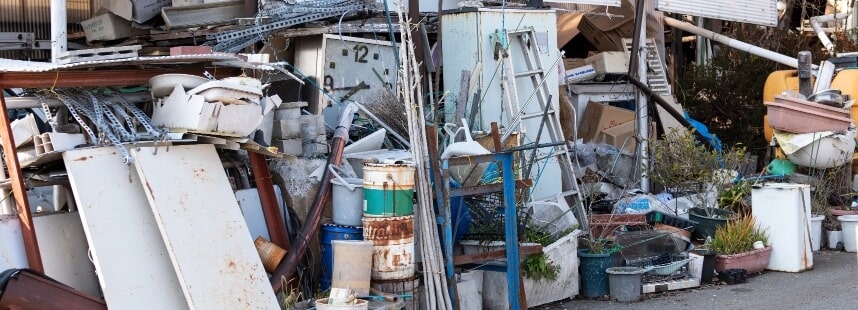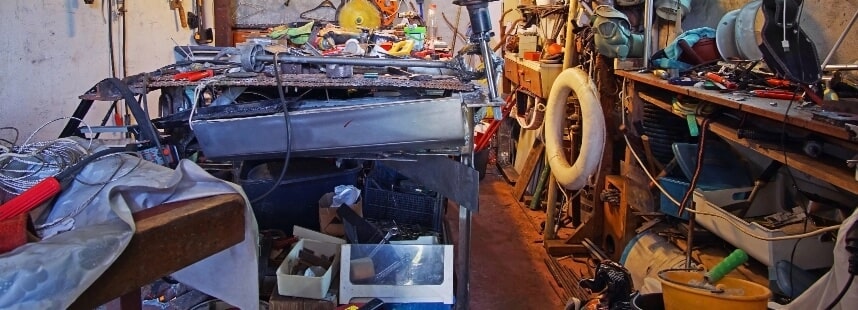Compulsive Hoarding, Also Known As Hoarding Disorder
This is a pattern of behavior that is characterized by excessive acquisition and an inability or unwillingness to discard large quantities of objects that cover the living areas of the home and cause significant distress or impairment.
In the homes of people who have hoarding disorder, the countertops, sinks, stoves, desks, stairways and virtually all other surfaces are usually stacked with stuff. And when there’s no more room inside, the clutter may spread to the garage, vehicles and yard.

Clutter and difficulty discarding things are usually the first signs and symptoms of hoarding disorder, which often surfaces during the teenage years. As the person grows older, he or she typically starts acquiring things for which there is no need or space. By middle age, symptoms are often severe and may be harder to treat.
Hoarding disorder affects emotions, thoughts & behavior. Signs & symptoms may include:

People with hoarding disorder typically save items because:

Hoarding disorder is different from collecting. People who have collections, such as stamps or model cars, deliberately search out specific items, categorize them and carefully display their collections. Although collections can be large, they aren’t usually cluttered and they don’t cause the distress and impairments that are part of hoarding disorder.
Hoarding not only can create egress and ingress issues for evacuating occupants but also can delay fire crews entering the structure. Often, exits are blocked and rooms are filled to the ceiling with stacks of belongings that can easily fall over and entrap firefighters.
Although firefighters may force open an inward-opening exterior door to enter, getting out through the same door may present a problem. Also, if a firefighter is in distress, accessing and removing him can be difficult. First responders have a double-edged sword to deal with—fire prevention and firefighter safety.
Many fire departments are experiencing serious fires, injuries, and deaths as the result of compulsive hoarding behavior. The excessive accumulation of materials in homes poses a significant threat to firefighters fighting fires and responding to other emergencies in these homes and to residents and neighbors.
Often, the local fire department will be contacted to help deal with this serious issue. Since studies suggest that between three and five percent of the population are compulsive hoarders, fire departments must become familiar with this issue & how to effectively handle it.
Why is hoarding an issue for the fire service?

Many companies such as maid services, junk removal firms and even basic contractors offer hoarding cleanup services. For them, hoarding cleanup is nothing more than removing what they believe to be is trash into a dumpster and charging the customer a small fortune. Aside from the fact that not everything you see is trash, as there can be valuables and other family heirlooms within the piles, but also what you may not be able to see is the damage lurking behind the items.
Quite a few hoarding cleanup jobs that we undertake result in the discovery of little to major water damage and mold. And when these two types of damage are seen, then you know hiring a regular contractor or a cleaning service is the wrong choice.
If you have a family member or friend suffering from a hoarding condition and in need of hoarding cleanup, take into consideration the strong possibility that large amounts of stored items and trash may not be the only issue, and you could have to deal with water damage and mold. And by hiring a hoarding cleanup company not capable of going beyond just the hoarding cleanup, could result in cross contamination and further damage.
Gross Filth Decontamination
Many people are aware of hoarding conditions, especially after the popular television show, but few are aware of another condition called, Gross Filth. This involves the cleaning and decontamination of an uninhabitable space which includes fecal matter, bodily fluids, excessive rubbish, expired food, potentially infectious materials, hazardous items, boxed items, mold, etc.
This does indeed require trained professionals who are certified in such removals due to the potential health and safety hazards. If there is someone you know who lives in such conditions, please don’t look the other way, or just consider them dirty, because they too are at a high level of risk of infection and many other potentially life threatening health issues. We have many areas we service for hoarding cleanup.

Hoarding Cleanup Services offered for residents of Philadelphia PA, Delaware County PA, Bucks County PA, Montgomery County PA, Chester County PA, Lehigh County PA, Camden County NJ, Mercer County NJ, Burlington County NJ, Gloucester County NJ, Monmouth County NJ & Delware.